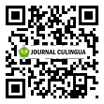RECOGNIZING GIFTED IN CHILDREN THROUGH LANGUAGE DEVELOPMENT AND CHARACTER EDUCATION AS A MEANS OF MAXIMIZING ABILITY
DOI:
https://doi.org/10.37301/culingua.v2i1.14Keywords:
Gifted children, language development, character education, mental, and attitudeAbstract
This study aims to describe and explain how to recognize gifted children through language development and steps to maximize abilities. This study used a qualitative method with a descriptive analysis approach without using statistical formulas or formulas or SPSS assistance. The data in this study were obtained from the analysis of conversation or dialogue as well as the development of the Early Dini Suryani language of the third-grade students of SDN 27 / III Lolo Kecil with their peers, interacting in class with the teacher and while in the family environment. Researchers found that early language development was different from normal children who tended to have the use of well-ordered and well-structured language. Dini also uses a variety of vocabulary that is appropriate for certain contexts. The use of intonation and facial expression in interacting was also applied by Dini in communicating. Even so, Dini has a mental disorder that is high egoistic like when she wants everything she will do even though she forces her will. To maximize early abilities character education is the right support step or method. Thus, Dini can be a gifted child with a good personality.
References
Ali, H., & Alrayes, A. (2019). The Role of Technology in Gifted and Talented Education: A Review of Descriptive and Empirical Research. KNOWLEDGE Journal, 1(1), 26–38. downloaded from https://doi.org/10.18502/kss.v3i24.5165
Ali, M. (2019). Gifted and Talented Education: A Review of Relevant Literature.
Alsamiri, Y. (2018). How Learning Disabilities Teachers In The Kingdom Of Saudi Arabia. Journal of Disabilities Studies, 1(1), 356–365.
Blaas, S. (2020). The Relationship Between Social-Emotional Difficulties and Underachievement of Gifted Students. Australian Journal of Guidance and Counseling, 24(2), 243–255.
Chowdhury, M. . (2017). Towards the Achievement of a Unified, Uniform and Socially- Just “Gifted Education” Policy Acceptable on a Global Scale. Journal for the Education of Gifted Young Scientists, 5(March), 1–22.
Fraser-seeto, K. (2013). Pre-service teacher training in gifted and talented education: An Australian perspective. Journal of Student Engagement: Education Matters, 3(1), 29–38.
Fraser-seeto, KT, Howard, S., & Woodcock, S. (2015). An Investigation of Teachers’ Awareness and Willingness to Engage with a Self-Directed Professional Development Package on Gifted and Talented Education. Australian Journal of Teacher Education, 40(1), 1–12.
Iskandar. (2008). Educational and Social Research Methodology (Quantitative and Qualitative). Gp press.
Mahsun. (2007). Language Research Methods: Stages, Strategies, and Techniques. Raha Grafindo Persada.
Maryanah, S. (2020). Indonesian Teachers’ Attitudes Towards Gifted Students with Low SES from Malay Background. Indonesia Journal of Disability Studies, 7(1), 110–118.
Murdock-smith, J. (2013). Understanding The Social And Emotional Needs Of Gifted Children. InSight: RIVIER ACADEMIC JOURNAL, 9(2), 2–5.
Ngiamsunthorn, P. S. (2020). Promoting creative thinking for gifted students in undergraduate mathematics. JRAMathEdu (Journal of Research and Advances in Mathematics Education), 5(1), 13–25. https://doi.org/10.23917/jramathedu.v5i1.9675
Rinn, A., Plucker, J., Stocking, V., Plucker, J., & Stocking, V. (2010). Fostering Gifted Students’ Affective Development: A Look at the Impact of Academic Self-Concept A Look at the Impact of Academic Self-Concept. Journal of TECPlus, 6(4), 1–15.
Sahin, F., & Levent, F. (2015). Examining The Methods And Strategies Which Classroom Teachers Use In The Education Of Gifted Students. The Online Journal of New Horizons in Education, 5(3), 69–78.
Sharp, L., & Clemmer, P. (2015). The Neglected Readers: Differentiating Instruction for Academically Gifted and Talented Learners The Neglected Readers: Differentiating Instruction for Academically Gifted and Talented Learners. The Journal of Balanced Literacy Research and Instruction, 3(1), 1–14.
Sugiyono. (2014). Educational Research Methods Quantitative, Qualitative, and R&D. In Educational Research Methods Quantitative, Qualitative, and R&D. Alfabeta.
Tekin, M., & Ta??in, Ö. (2009). Analysis of the creativity level of the gifted students. ELSEVIER, 1(1), 1088–1092. https://doi.org/10.1016/j.sbspro.2009.01.196
Utami, H., & Ashadi, A. (2018). Direct EFL Instruction for Gifted Students: A Case Study. Celt: A Journal of Culture, English Language Teaching & Literature, 18(2), 1–12. https://doi.org/10.24167/celt.v18i2.870
Zimlich, S. L. (2016). Motivating Gifted Students?: Technology as a Tool for Authenticity and Autonomy. International Journal of Learning, Teaching, and Educational Research, 15(13), 1–11.
Downloads
Published
Issue
Section
License
Copyright (c) 2021 Dedi Saputra Nasri

This work is licensed under a Creative Commons Attribution 4.0 International License.









